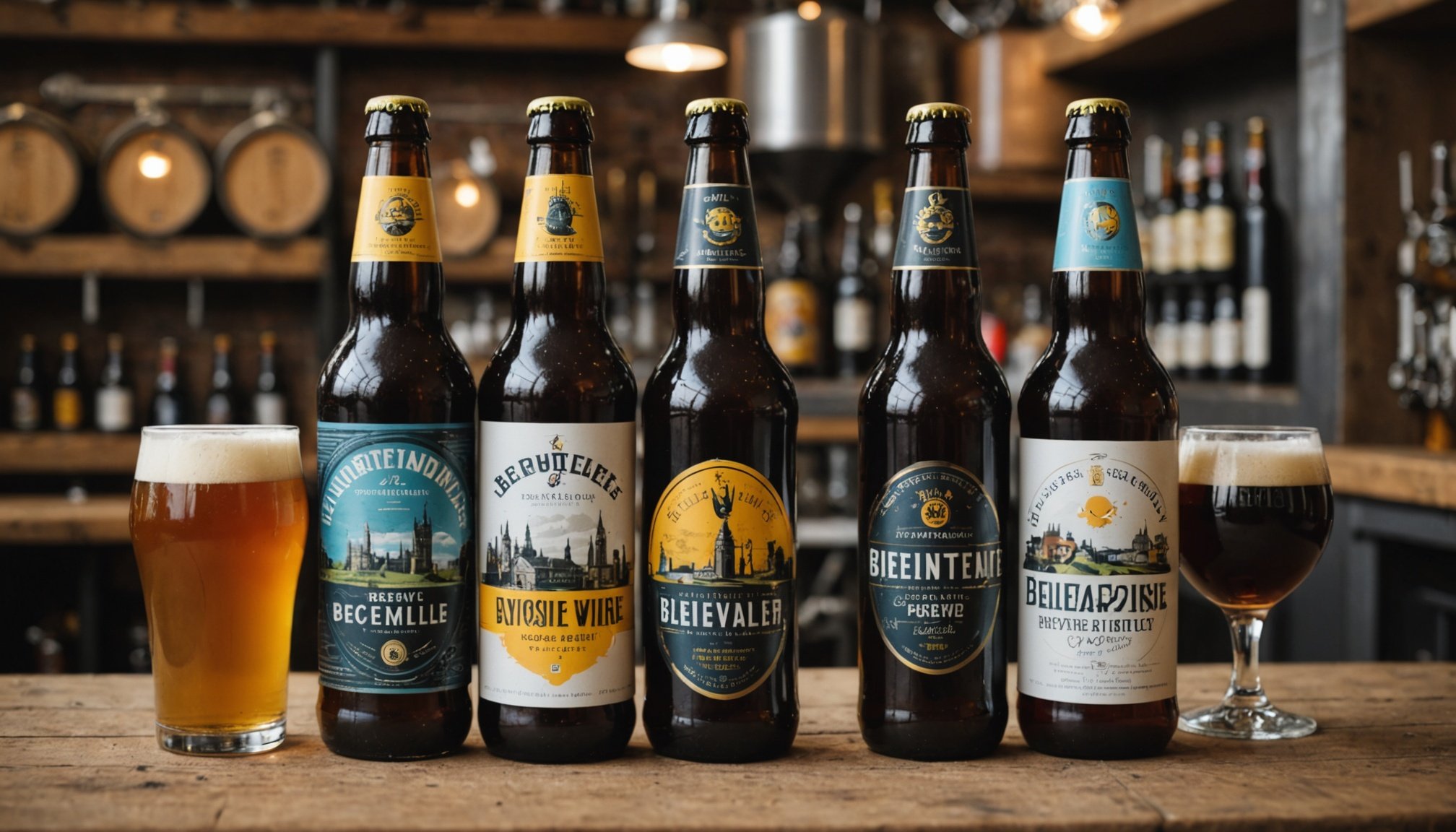The Rise of Local Ingredient Brewing
The trend towards utilizing local ingredients in the UK brewery industry is gaining momentum, transforming how craft beers are perceived and appreciated. Driven by the demand for authenticity and community support, many breweries are turning to locally-sourced components. This shift not only enhances the distinct characteristics of craft beers but also reinforces connections between breweries and their local communities.
Using local ingredients in brewing is reshaping the landscape by emphasizing the importance of terroir. Breweries across the UK have begun creating beers with unique regional flavors, which distinguish them from their counterparts. Furthermore, relying on ingredients close to home reduces carbon footprints, aligning with sustainable practices.
This might interest you : Powerful UK SEO Techniques: Elevate Your Digital Marketing Success
Several forward-thinking breweries are leading the way in this trend, prominently featuring local ingredients. These breweries aim to not only create memorable beers but also to bolster local economies, promote sustainability, and celebrate regional diversity within the UK’s brewing industry. By highlighting the benefits of local sourcing, they encourage more breweries to adopt similar practices, ultimately enriching the craft beer experience for consumers seeking unique flavors and authenticity.
Key Local Ingredients in UK Brewing
Local ingredients play a vital role in shaping the distinct character of UK craft beer. By embedding regional ingredients into brewing, breweries generate unique flavors that honour their locales’ natural bounty. This approach not only enriches taste profiles but also fosters a deeper connection to local heritage.
In parallel : Effective Approaches to Enhancing Customer Loyalty in UK Subscription Services: Tried-and-True Retention Strategies
Popular Herbs and Botanicals
Incorporating indigenous herbs, like heather and bog myrtle, creates not only distinctive flavor contributions but also draws from historical uses in local brewing traditions, adding a layer of cultural significance.
Specialty Grains and Malts
The choice of grains, such as locally farmed barley, directly affects beer’s flavour, offering a unique palate anchored in the regional soil. BrewDog is one example, sourcing grains from Scottish maltsters to develop signature beers.
Indigenous Hops Varieties
Exploring UK hop varieties, such as Goldings and Fuggles, provides brewers with local alternatives to traditional imports. These indigenous hops impart differing taste notes that showcase the terroir, granting each region its flavour identity.
Emphasizing these local ingredients enables the UK brewing landscape to flourish with uniquely regional flavours, supporting both the craft beer industry and local agriculture.
The Innovative Brewing Process
Utilizing unique brewing techniques for local ingredients revolutionizes the UK’s brewery industry. By adapting methods, breweries amplify regional flavors innate to (local ingredients). This innovation fosters individuality, offering consumers a varied palate to explore.
Sustainability is integral to these processes. Breweries committing to sustainable practices, such as water recycling and energy-efficient equipment, reduce their environmental footprint. Additionally, sourcing ingredients locally means less transportation, bolstering sustainability efforts in brewing.
The fermentation stage benefits significantly from sustainable practices. Natural fermentation processes, often prolonged or adjusted depending on the freshness and specific properties of regional ingredients, yield more distinct beers. The result is a diverse range of brews, highlighting terroir in every sip.
Breweries leading this trend find that local ingredient sourcing not only enhances flavor but also supports regional economies. As the demand for UK craft beer flourishes, integrating these methods strengthens ties to communities and landscapes. Through innovative brewing processes, the industry captures the essence of local terroir, providing consumers with beers that narrate a story of tradition, sustainability, and bold flavors from the UK.
Flavor Profiles and Taste Experiences
Incorporating local ingredients fundamentally alters the flavor development of UK craft beer. Each component adds unique nuances that significantly contribute to the beer’s identity. Regional ingredients like Scotland’s sweet heather honey or English hedgerow berries infuse beers with distinct tasting notes, reflecting the land where they are grown.
Sensory analysis highlights these transformations, offering brewers insights into the complex interplay of ingredients. For example, a beer brewed with Kentish hops might present floral and earthy qualities distinct to that region, showcasing terroir. These flavours are carefully balanced to provide a full-bodied experience, rich in local terroir.
Furthermore, specialized brewing techniques ensure the vivid flavor profiles remain pronounced throughout the tasting journey. Beers using Welsh grains may develop a creamy texture that feels comforting with every sip, elevating the sensory experience.
By exploring such local flavours, consumers embark on a tasting journey that is both engaging and informative. Each beer becomes a voyage, narrating a story through its taste experiences that connects the drinker to the geographic and cultural roots of its origins.
Cultural Significance of Local Brewing Practices
The cultural significance of incorporating local ingredients in UK brewing extends beyond just flavor. It serves as a bridge to community engagement, reviving a sense of tradition and brewing heritage. Local brews act as a canvas, painting rich tapestries of the UK’s diverse cultural landscape. Each brew resonates with the history, stories, and customs of its originating region. Through this, breweries foster a deep-rooted community connection, strengthening local ties.
One notable impact is the revival of ancient recipes and methods that were once cornerstones of regional brewing heritage. By enlisting the help of local growers and artisans, these practices breathe new life into time-honored traditions. The result is an array of singular beers steeped in history.
Furthermore, the collaborative nature of using regional ingredients nurtures community engagement. Many breweries host events, workshops, and tours that educate and inform about the importance of local sourcing. These interactions not only enhance consumer appreciation for UK craft beer but also support local economies. Ultimately, this emphasis on tradition and community cements the significance of local brewing practices as more than just a trend—it’s a movement honoring the past while looking towards the future.
Health Benefits and Environmental Impact
The increasing focus on organic ingredients in UK breweries offers several potential health benefits. By using fewer chemicals and emphasising natural growth processes, these ingredients may reduce the exposure to additives often found in mass-produced beers. This shift not only aligns with consumer demand for healthier options but also supports the integrity of craft beer production.
Environmental concerns have also spurred the adoption of sustainability in brewery practices. By sourcing ingredients locally, breweries significantly cut down on transportation emissions, decreasing their carbon footprint. This approach underscores a commitment to environmentally-friendly brewing, enhancing the ecological impact. Choosing local suppliers not only supports nearby economies but also fosters an ecosystem where brewers and local farmers can thrive together.
The ethical and health-focused brewing initiatives are gaining traction in the UK. Some breweries actively incorporate educational programmes about their sustainable practices. These initiatives aim to raise awareness about the benefits of local sourcing and demonstrate the positive impact on health and the environment. As a result, consumers engaging with these environmentally-conscious breweries are not only indulging in great-tasting ales but also contributing to a more sustainable world.
Brewer Interviews and Insights
Gaining insights from local brewers shines a light on the intricate tapestry of using local ingredients in UK craft beer. During interviews, brewers frequently express how the incorporation of locally-sourced elements not only amplifies flavour but also deepens community ties. They often reference the unique regional ingredients accessible in their locales, such as hops and grains that define their brew’s distinct palate.
Interviews with Local Brewers
Brewers speak candidly about the challenges and rewards of ingredient sourcing. One brewer reflects, “The logistics of sourcing nearby can be daunting, but the resulting flavours and sustainable benefits make it worth the effort.” They highlight how local ingredients, although sometimes costlier or harder to procure, yield significant returns in customer appreciation and environmental impact.
Quotes Reflecting Brewing Philosophy
Brewing is as much about philosophy as it is about taste. Local brewers emphasize their commitment to community and tradition. One states, “Every pint we pour tells the story of our region.” Such perspectives reveal how local sourcing aligns with a broader commitment to authenticity and excellence. This philosophy underscores the transformative impact of embracing a locality-focused approach in brewing.
Visual Engagement: Photos and Infographics
To capture the essence of local ingredients in the UK craft beer scene, engaging visuals play a pivotal role. Brewery visuals help narrate the journey of each beer, from conception to consumption. Suggested imagery, like vibrant shots of ingredients, the brewing process, and finished products, vividly illustrate the transformation of raw materials into crafted excellence.
Incorporating infographics further enhances understanding and appreciation of the brewing process. Maps highlighting regional sources of hops or diagrams showing sustainable practices adopted by breweries offer transparent insights into production. This visual storytelling not only educates but also strengthens community engagement, inviting consumers into the narrative of their brew.
Breweries can use visuals strategically in marketing materials to emphasise the uniqueness and authenticity of their craft. High-quality images on social media and websites generate interest and establish an emotional connection with the consumer. Additionally, infographics that compare traditional and innovative brewing methods provide clarity and showcase the impact of local ingredients on flavour development. By using these visual tools effectively, breweries can enrich the consumer’s experience and introduce them to the rich tapestry behind each pint of UK craft beer.











